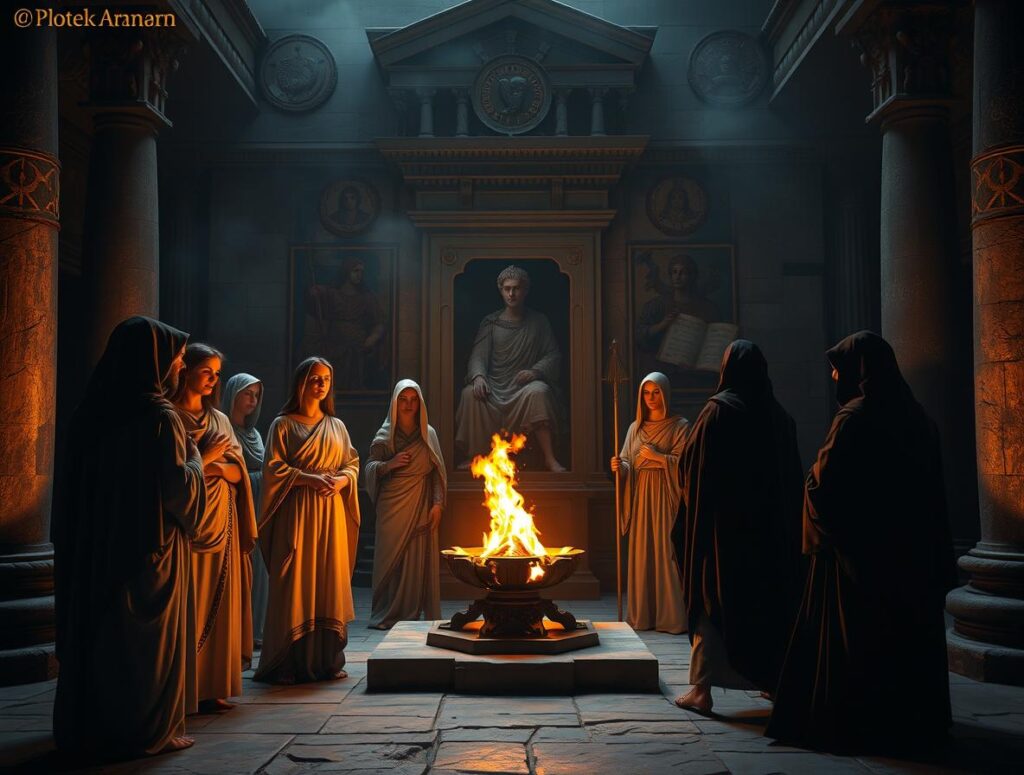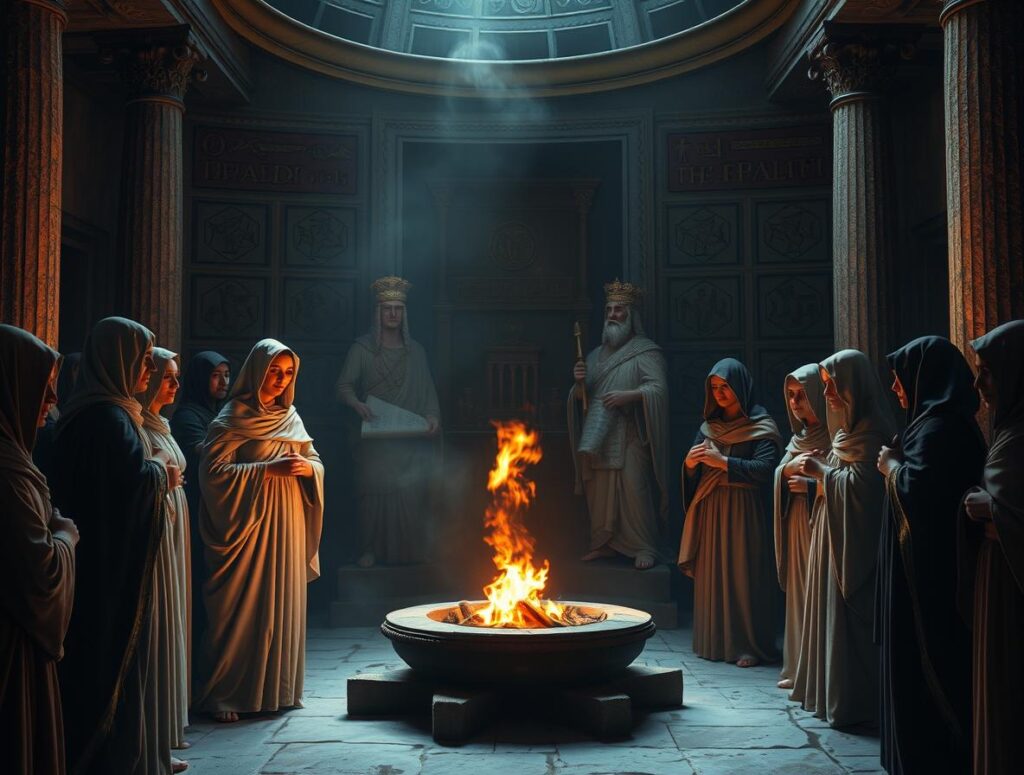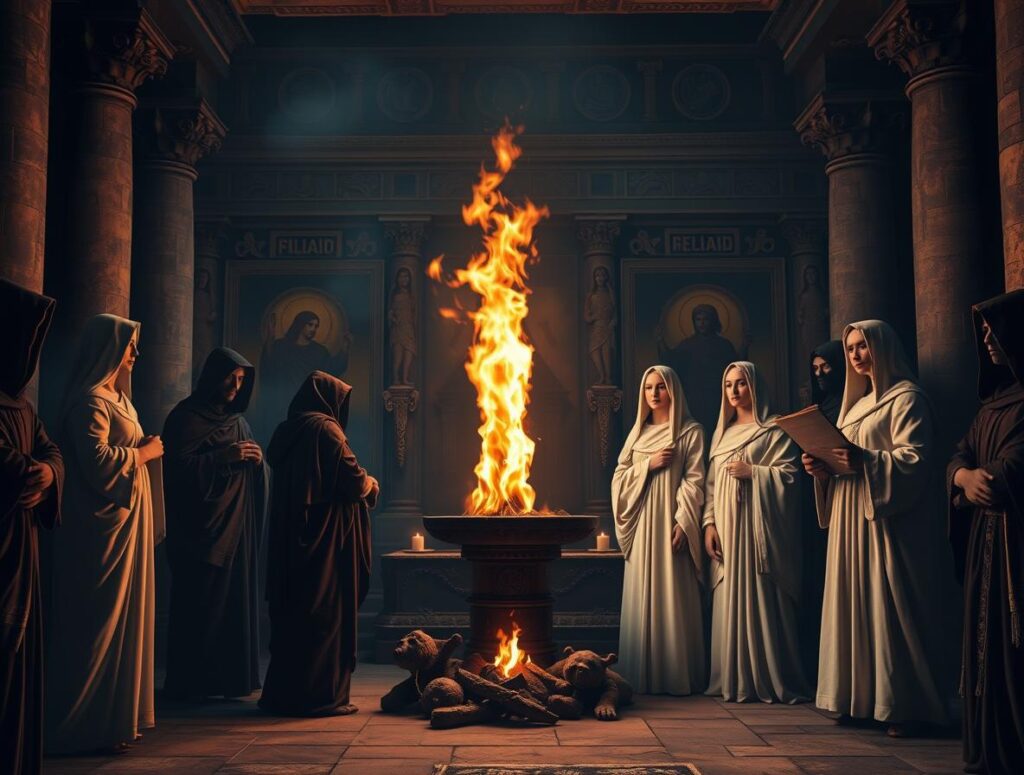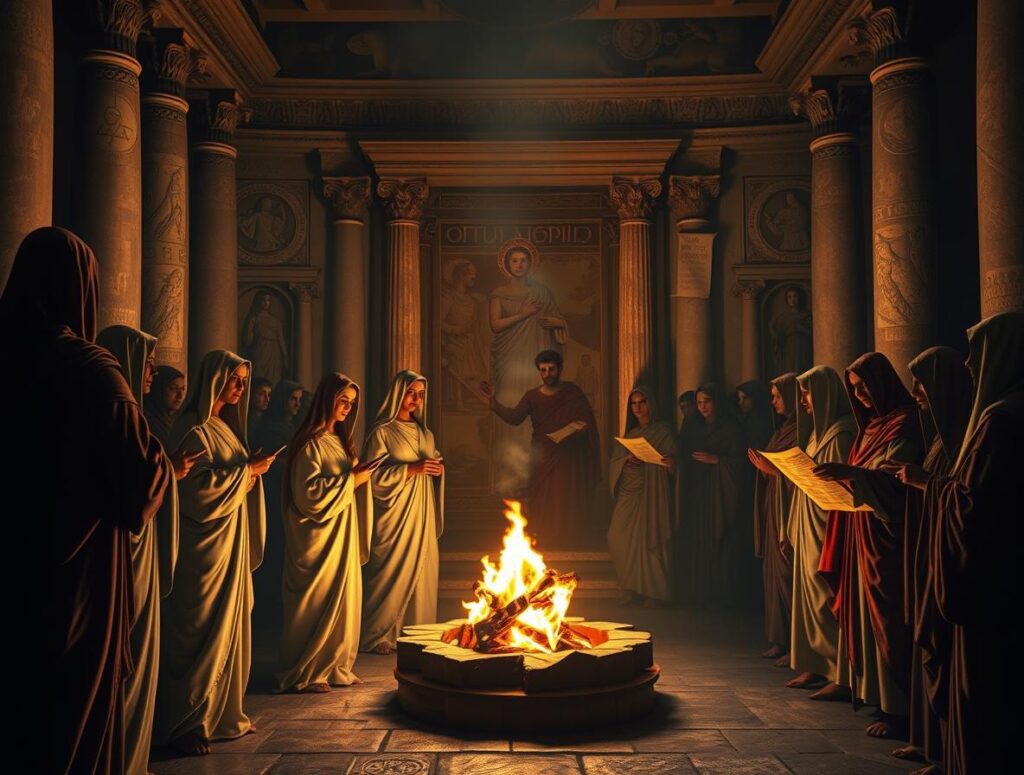The Rome you think you know is a carefully curated illusion. While modern depictions focus on gladiatorial combat, military conquests, and architectural marvels, they routinely miss the invisible force that truly shaped Roman civilization – a religious system so intricately woven into daily life that it would be unrecognizable to most contemporary observers. This wasn’t merely religion as we understand it today; it was a complex theological framework that simultaneously bound together and stratified Roman society in ways that determined everything from political advancement to household management.
What history books often reduce to a footnote – “Romans were polytheistic and later adopted Christianity” – actually represents one of the most sophisticated religious ecosystems ever developed. The average Roman navigated a world where divine forces required constant negotiation, where personal advancement hinged on religious participation, and where the boundary between political office and religious authority was virtually nonexistent. In many ways, understanding these hidden dimensions of Roman religious practice provides greater insight into their civilization than any battlefield victory or architectural achievement.
The Political Priesthood: How Religious Offices Controlled Rome’s Destiny
When modern historians discuss Roman politics, they often focus on the Senate, consuls, and eventually emperors, but they frequently overlook how the religious college of pontiffs exerted tremendous influence over every aspect of governance. The position of Pontifex Maximus – Rome’s chief priest – wasn’t merely a religious title but a critical political office that conferred immense power. This wasn’t simply a ceremonial role; it represented control over the Roman calendar (determining when assemblies could meet), the authority to interpret omens (potentially delaying unfavorable legislation), and even the ability to invalidate elections.
The genius of the Roman system was how thoroughly it merged religious and political authority. Julius Caesar considered his election as Pontifex Maximus more significant than many of his military victories, understanding that religious authority provided an avenue of influence that military might alone could not secure. When Augustus later incorporated the title into the imperial office, he wasn’t simply accumulating religious honors – he was ensuring that no religious authority could challenge imperial power. By controlling both civil and religious offices, Augustus cleverly eliminated a potential source of opposition.
What makes this system particularly fascinating is how Romans viewed this fusion of religion and politics not as corruption but as essential to maintaining proper relations with the gods. The concept of religio – maintaining correct ritual practice – was seen as vital to Rome’s success. Far from being window dressing, proper religious observance was understood as the foundation upon which Roman prosperity rested. The pontiffs weren’t merely performing ceremonies; they were preserving the pax deorum (peace with the gods) that allowed Rome to flourish.

The Vestal Mysteries: Female Power in a Patriarchal Society
Perhaps no aspect of Roman religion is more misunderstood than the role of the Vestal Virgins. Modern accounts often reduce these women to curiosities – virgins maintaining an eternal flame. This simplification misses the extraordinary complexity of their position and the unusual power they wielded in an otherwise patriarchal society. The Vestals occupied a unique legal category, emancipated from their fathers’ authority while maintaining citizenship rights unavailable to other women. They could own property, make wills, and testify in court without a male guardian – privileges unheard of for other Roman women.
The Vestals’ primary responsibility was maintaining the sacred flame in the Temple of Vesta, believed to be connected to Rome’s very survival. This wasn’t merely symbolic – Romans genuinely believed that if the flame extinguished, it portended disaster for the state. But their responsibilities extended far beyond tending the flame. Vestals prepared the mola salsa (sacred salt cake) used in state sacrifices and safeguarded important state documents, including wills. Their participation was required at major state functions, and they held reserved seats at public games, often near the emperor himself.
What truly distinguished the Vestals was their liminal status – neither fully human nor divine, neither married women nor typical virgins. This in-between state granted them extraordinary influence. A condemned prisoner who happened to meet a Vestal on the way to execution could receive pardon. Their physical presence could prevent violence, and their intercession could sway even emperors. The price for this power was severe – a Vestal who broke her vow of chastity faced being buried alive, one of the few instances where Romans practiced human sacrifice within their borders. This terrible punishment wasn’t merely about sexual purity but about the cosmic disorder created when a Vestal violated her sacred obligations.
The Household Gods: Religion as Daily Practice
While public ceremonies and state religion capture historical attention, the most pervasive form of Roman religious practice occurred within ordinary homes, largely invisible to outside observers. Every Roman household maintained a lararium – a shrine to the household gods that served as the spiritual center of family life. These shrines housed representations of the Lares (ancestral spirits), Penates (guardians of the storeroom), and often the genius of the paterfamilias (the living spirit of the household head). Daily rituals at the lararium weren’t optional cultural practices but essential acts that protected the family and ensured its prosperity.
The paterfamilias served as the household priest, offering daily libations, maintaining the shrine, and leading family members in proper observance. Special offerings marked significant family events – births, marriages, deaths, and transitions to adulthood. The boundary between religion and daily life simply didn’t exist for Romans; ordinary activities like preparing food, crossing thresholds, or lighting lamps carried religious significance and required proper observance. Modern historians often overlook these practices precisely because they were so commonplace, yet they formed the foundation of Roman religious experience.
What makes household worship particularly fascinating is how it provided religious agency to those often excluded from public ceremonies. While the paterfamilias led household worship, women, children, and even slaves participated in daily rituals. During the Compitalia festival, slaves could make offerings at neighborhood shrines, temporarily inverting the usual social hierarchy. This domestic religion created a parallel system where those excluded from public religious offices could still maintain meaningful religious practices. For most Romans, these daily household rituals, not grand public ceremonies, constituted their primary religious experience.

Mystery Cults: The Fight Club of Roman Religion
Perhaps the most deliberately obscured aspect of Roman religious life was the participation in mystery cults – secretive religious groups that required initiation and demanded absolute silence about their practices. Unlike state religion, which focused on correct action rather than personal belief, mystery cults offered transformative personal experiences and promises of favorable afterlife. These cults operated alongside traditional Roman religion, not in opposition to it, creating a complex religious ecosystem where Romans could simultaneously maintain traditional practices while seeking deeper spiritual experiences.
The Eleusinian Mysteries, though Greek in origin, attracted Roman participants including emperors. Initiates underwent secret rituals at Eleusis near Athens, experiencing what one ancient writer called “a thing of horror transformed into a thing of beauty.” Whatever occurred during these ceremonies remained remarkably secret – despite thousands of participants over centuries, the core rituals were never revealed in surviving literature. Participants returned transformed, with many reporting diminished fear of death and a new understanding of life’s purpose.
The cult of Mithras represented another dimension of mystery religion, primarily attracting soldiers and merchants. Mithraic temples (called mithraea) were deliberately built underground or in cave-like structures, creating spaces that simulated the primordial cave where Mithras was believed to have slain the cosmic bull. These small spaces typically accommodated only 30-40 initiates, creating intimate communities bound by shared secret knowledge. The initiation involved seven grades, each with its own trials and revelations, creating a progressive journey toward spiritual enlightenment. What makes Mithraism particularly fascinating is how it created social bonds that transcended traditional Roman hierarchies – a wealthy merchant and common soldier could participate as equals within the mithraeum while maintaining their separate social positions outside it.
The Bacchic Mysteries perhaps best demonstrate Roman ambivalence toward mystery religions. Initially tolerated, the Senate violently suppressed Bacchic worship in 186 BCE, executing thousands of participants. This wasn’t merely religious persecution but fear of the social disruption created when women and men gathered in secret, outside traditional social constraints. The Bacchanalian affair reveals how religious practice that challenged social hierarchies could be perceived as threatening the very foundations of Roman society. Despite this suppression, modified forms of Bacchic worship eventually returned, demonstrating the persistence of mystery traditions even in the face of official opposition.
Divine Diplomacy: How Rome Absorbed Foreign Gods
Rome’s extraordinary religious syncretism – the ability to incorporate foreign deities into their pantheon – wasn’t merely cultural openness but a sophisticated theological and political strategy. When Romans encountered foreign peoples, they didn’t merely conquer territories but engaged in a form of divine diplomacy, identifying local gods with Roman equivalents (interpretatio romana) and often bringing worship of these deities back to Rome itself. This wasn’t random spiritual appropriation but a careful process overseen by religious authorities who determined which foreign cults could be incorporated and under what conditions.
The evocatio ritual perfectly encapsulates this approach. When besieging enemy cities, Roman generals would perform a ceremony inviting the patron deity of the city to abandon their current worshippers and join the Roman pantheon, where they would receive greater honor and more elaborate worship. This wasn’t merely psychological warfare but represented a genuine theological belief that gods could be persuaded to switch allegiance. After conquest, Romans would establish worship of these “captured” deities, effectively integrating the conquered population’s religious identity into the Roman system.
This religious flexibility created a remarkably adaptive system that helped Rome manage its diverse empire. When Cybele (the Great Mother) was brought to Rome during the crisis of the Second Punic War, her foreign worship was carefully regulated – Roman citizens were initially forbidden from becoming her priests, maintaining a distinction between traditional Roman religion and this powerful but potentially disruptive foreign cult. Over time, these restrictions relaxed as the cult became more thoroughly “Romanized.” This pattern repeated across the empire – foreign cults were simultaneously embraced and transformed, creating religious connections that helped bind the empire together.
Divination: Reading the Will of the Gods
Modern accounts often treat Roman divination as superstition or political theater, but this fundamentally misunderstands its central role in Roman decision-making. The Romans developed elaborate systems for interpreting divine will through natural phenomena, creating specialized colleges of priests dedicated to reading signs from the gods. The College of Augurs interpreted the flight patterns of birds, while haruspices examined animal entrails for abnormalities that might indicate divine displeasure. These weren’t peripheral practices but central to both public and private decision-making.
What makes Roman divination particularly fascinating is its blend of strict procedural rules and interpretive flexibility. Augural practice involved precisely defined sacred spaces (templa) and careful observation of birds within specific sectors of the sky. Negative omens could delay elections, halt military campaigns, or invalidate legislation. Yet this rigid system contained remarkable interpretive flexibility – the same omen could be interpreted differently depending on context, allowing religious authorities considerable influence over how divine messages were understood.
The political dimension of divination became increasingly apparent during the Late Republic, when religious objections frequently delayed politically inconvenient assemblies or elections. When Bibulus, Caesar’s co-consul, announced he was “watching the sky” for omens (effectively closing down public business), he was using religious procedure for political obstruction. Far from being dismissed as superstition, these religious objections carried legitimate constitutional weight. This wasn’t cynical manipulation but represented the complex intersection of religious and political authority in a society where these domains were fundamentally inseparable.

The Deification Factory: How Humans Became Gods
Perhaps the most radical aspect of Roman religion was the systematic process for transforming humans into gods through apotheosis. While modern accounts often treat emperor worship as imperial propaganda, this misunderstands the complex theological framework that made such transformations conceivable within Roman religious thinking. The concept of the genius – the divine element within a person – provided the theological foundation for understanding how exceptional humans might join the divine realm after death.
The process of consecratio (deification) began with Julius Caesar, whose comet-marked funeral pyre was interpreted as visible evidence of his soul ascending to join the gods. Augustus systematized this process, carefully laying groundwork for his own deification by establishing cult to the deified Julius. What followed was essentially a religious technology for manufacturing gods – a formal Senate vote, witnessed ascension (usually an eagle released from the funeral pyre), establishment of priesthoods, and construction of temples. This wasn’t empty ceremony but created new divine entities who received regular worship and were believed to intercede for the Roman state.
What makes this system particularly fascinating is how it blended religious belief with practical politics. Deification became a way of evaluating an emperor’s reign – “bad” emperors like Caligula or Nero were denied consecration, while “good” emperors joined the divine pantheon. This created a powerful incentive for imperial good behavior, at least in theory. The practice extended beyond emperors to imperial family members, particularly women like Livia and Drusilla, creating female divine models alongside male ones. Far from being mere flattery, imperial cult created a religious framework that helped legitimize imperial rule and bind together disparate populations across the empire.

Beyond the Veil: What Roman Religion Teaches Us About Hidden Histories
The complexity of Roman religious practice reveals how easily fundamental aspects of historical societies can be obscured or oversimplified in modern accounts. Roman religion wasn’t a collection of quaint customs or political manipulation but a sophisticated system that permeated every aspect of life. By recognizing how thoroughly religion shaped Roman experience – from political decision-making to household management – we gain a more accurate understanding of their civilization than accounts focused solely on military conquests or architectural achievements.
This exploration of Roman religion also reveals the limits of our modern categories. The Romans had no concept of “religion” as a separate domain distinct from politics, family life, or civic identity. What we label “religious” was for them simply part of being Roman. This insight challenges us to reconsider how we approach historical societies, recognizing that our modern conceptual divisions may obscure rather than illuminate how people in the past understood their world.
The hidden dimensions of Roman religious practice remind us that historical knowledge is always partial and provisional. What survives in historical records often reflects elite perspectives and public ceremonies, while the lived religious experience of ordinary people remains largely invisible. By looking beyond temple walls to household shrines, beyond public ceremonies to mystery initiations, we catch glimpses of a religious world far more complex and nuanced than simplified historical accounts suggest. In doing so, we’re reminded that the past is not a fixed narrative but a complex landscape that rewards deeper exploration.
The next time you encounter simplified accounts of Roman religion – or any historical religious system – consider what might lie beneath the surface. The most fascinating aspects of human history often exist in these hidden dimensions, waiting for those willing to look beyond conventional narratives. The true nature of Roman civilization becomes visible not just in their monuments and military victories, but in the invisible theological frameworks that shaped how they understood their world and their place within it.

